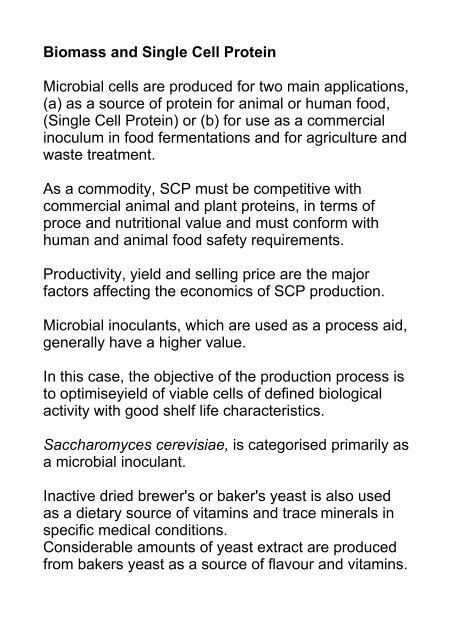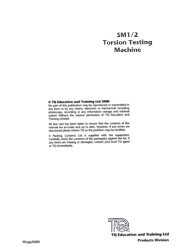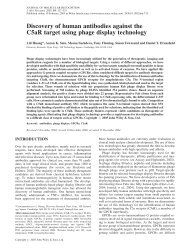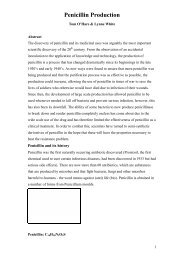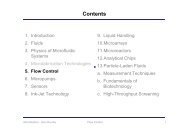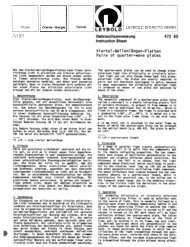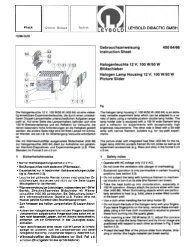Biomass and Single Cell Protein Microbial cells are produced ... - DCU
Biomass and Single Cell Protein Microbial cells are produced ... - DCU
Biomass and Single Cell Protein Microbial cells are produced ... - DCU
Create successful ePaper yourself
Turn your PDF publications into a flip-book with our unique Google optimized e-Paper software.
<strong>Biomass</strong> <strong>and</strong> <strong>Single</strong> <strong>Cell</strong> <strong>Protein</strong><br />
<strong>Microbial</strong> <strong>cells</strong> <strong>are</strong> <strong>produced</strong> for two main applications,<br />
(a) as a source of protein for animal or human food,<br />
(<strong>Single</strong> <strong>Cell</strong> <strong>Protein</strong>) or (b) for use as a commercial<br />
inoculum in food fermentations <strong>and</strong> for agriculture <strong>and</strong><br />
waste treatment.<br />
As a commodity, SCP must be competitive with<br />
commercial animal <strong>and</strong> plant proteins, in terms of<br />
proce <strong>and</strong> nutritional value <strong>and</strong> must conform with<br />
human <strong>and</strong> animal food safety requirements.<br />
Productivity, yield <strong>and</strong> selling price <strong>are</strong> the major<br />
factors affecting the economics of SCP production.<br />
<strong>Microbial</strong> inoculants, which <strong>are</strong> used as a process aid,<br />
generally have a higher value.<br />
In this case, the objective of the production process is<br />
to optimiseyield of viable <strong>cells</strong> of defined biological<br />
activity with good shelf life characteristics.<br />
Saccharomyces cerevisiae, is categorised primarily as<br />
a microbial inoculant.<br />
Inactive dried brewer's or baker's yeast is also used<br />
as a dietary source of vitamins <strong>and</strong> trace minerals in<br />
specific medical conditions.<br />
Considerable amounts of yeast extract <strong>are</strong> <strong>produced</strong><br />
from bakers yeast as a source of flavour <strong>and</strong> vitamins.
<strong>Single</strong> <strong>Cell</strong> <strong>Protein</strong> Production<br />
Product Safety <strong>and</strong> Quality<br />
SCP has applications in animal feed, human food <strong>and</strong><br />
as functional protein concentrates.<br />
Some bacterial SCP have amino acid profiles similar<br />
to animal/plant protein. Yeast, fungal <strong>and</strong> soya bean<br />
proteins tend to be deficient in methionine.<br />
Ingestion of RNA from non-conventional sources<br />
should be limited to 50g per day. Ingestion of purine<br />
compounds arising from RNA breakdown, leads to<br />
increased plasma levels of uric acid, which can cause<br />
gout <strong>and</strong> kidney stones.<br />
High content of nucleic acids causes no problems to<br />
animals since uric acid is converted to allantoin which<br />
is readily excreted in urine.<br />
Nucleic acid removal is not necessary from animal<br />
feeds but is from human foods.<br />
A temperature hold at 64C inactivates fungal<br />
proteases <strong>and</strong> allows RNA-ases to hydrolyse RNA<br />
with release of nucleotides from cell to culture broth.<br />
A 30 min st<strong>and</strong> at 64C reduces intracellular RNA<br />
levels in Fusarium graminearum from 80mg/g to<br />
2mg/g.
Production<br />
Large scale fermenters <strong>are</strong> required<br />
High biomass productivity requires high oxygen<br />
transfer rates which promotes high respiration rates<br />
which in turn increase metabolic heat production <strong>and</strong><br />
the need for an efficient cooling system.<br />
In order to maximise fermentation productivity it is<br />
essential to operate continuous fermentation<br />
processes.<br />
Different processes have adopted different fermenter<br />
designs with respect to process requirements.<br />
BP Process – C<strong>and</strong>ida on n-paraffin<br />
Mechanically agitated fully baffled fermenters with<br />
turbine mixers.<br />
Reactor feed consists of paraffin, gaseous ammonia<br />
<strong>and</strong> other salts.<br />
Oxygen requirements per unit biomass <strong>produced</strong> by<br />
aerobic micro-organisms grown on n-hexadecane is<br />
2.5 times higher rhan that required for growth on<br />
glucose <strong>and</strong> amounts to 2.2 kg O2 per kg biomass.<br />
Heat <strong>produced</strong> was 25000 kJ/kg biomass. Fermenters<br />
require substantial agitation.
Because of the insoluble nature of alkanes, they exist<br />
in agiteated fermenter as suspensions of alkane drops<br />
1-100μm in diameter.<br />
<strong>Cell</strong> recovery is by centrifugation, producing 15% dry<br />
solids, evaporation to 25% dry solids <strong>and</strong> spray<br />
drying.<br />
ICI Process – Methylophilus methylotrophus from<br />
methanol.<br />
Pressure recycle fermentor. A combination of an airlift<br />
<strong>and</strong> loop reactor consisting of an airlift column, a<br />
down-flow tube with heat removal <strong>and</strong> a gas-release<br />
space.<br />
The nitrogen source is ammonia gas <strong>and</strong> pH is<br />
controlled between 6 <strong>and</strong> 7.<br />
<strong>Cell</strong> specific growth rate is approximately 0.5h -1 <strong>and</strong><br />
cell yield of 0.5 g/g.<br />
Methanol is oxidised via dehydrogenation to<br />
formaldehyde which can either be assimilated for<br />
conversion to cell mass or further oxidised to CO2 with<br />
concomitant energy production.<br />
<strong>Cell</strong>s <strong>are</strong> recovered by agglomeration followed by<br />
centrifugation, flash dried <strong>and</strong> ground.
Bel Fromageries process: Kluyveromyces<br />
marxianus from whey.<br />
Whey which contains about 5% lactose, 0.8% protein<br />
<strong>and</strong> 0.2-0.6% lactic acid, is used as a substrate.<br />
<strong>Biomass</strong> production requires an aerobic fermentation<br />
whereas aeration is minimal for ethanol production.<br />
For feed grade biomass, the entire fermentation<br />
contents, containing yeast, residual whey proteins,<br />
minerals <strong>and</strong> lactic acid may be recovered.<br />
For preparation of food grade material, <strong>cells</strong> <strong>are</strong><br />
harvested by centrifugation, washed <strong>and</strong> dried.<br />
<strong>Cell</strong> yield is 0.45-0.55 g/g based on lactose<br />
consumed.<br />
RHM Mycoprotein process: Fusarium<br />
graminearum from glucose.<br />
Medium components include food grade glucose<br />
syrup, gaseous ammonia, salts, <strong>and</strong> biotin.<br />
Fermentation pH is controlled at 6 by gaseous<br />
ammonia addition, fed into the air inlet stream.<br />
<strong>Cell</strong> concentrations <strong>are</strong> 15-20g/L <strong>and</strong> a specific<br />
growth rate of up to 0.2h -1 is achieved.<br />
Following cyclone separation <strong>and</strong> an RNA reduction
step, <strong>cells</strong> <strong>are</strong> recovered by rotary vacuum filtration<br />
<strong>and</strong> formulated into a range of products.<br />
Potential Substrates for SCP Production<br />
Sulphite waste liquor<br />
C<strong>and</strong>ida utilis has been <strong>produced</strong> as a protein<br />
supplement by fermentation of sulphite waste liquor in<br />
Germany during both world wars.<br />
More recently a Finnish company developed a fungal<br />
SCP production process, the Pekilo Process, to grow<br />
Paecilomyces varioti using sulphite waste liquor.<br />
<strong>Cell</strong>ulose<br />
<strong>Cell</strong>ulose from natural sources <strong>and</strong> waste wood is an<br />
attractive starting material for SCP production<br />
because of its abundance.<br />
The association of cellulose with lignin in wood makes<br />
it somewhat intractable to microbial degradation.<br />
Thermal or chemical pretreatment, used in<br />
combination with enzymatic hydrolysis, is usually<br />
required.<br />
Systems using cellulolytic organisms appear to have<br />
promise, but economic viability has yet to be<br />
achieved.
Whey<br />
Whole milk whey or deproteinised whey is a<br />
carbohydrate source, which creates disposal<br />
problems. (High BOD)<br />
Problems associated with whey for SCP production<br />
<strong>are</strong> usually insifficient substrate, seasonal supply<br />
variations <strong>and</strong> its high water content (>90%) which<br />
makes transport prohibitively expensive.<br />
While most organisms do not grow on lactose as a<br />
carbon source, strains of the yeast Kluyveromyces<br />
marxianus readily grow on lactose.<br />
Starch<br />
The symba process was developed in Sweden to<br />
produce SCP from potato starch using two yeast<br />
strains.<br />
Saccharomyces fibuligera produces the enzyme<br />
necessary for starch degradation enabling co-growth<br />
of C<strong>and</strong>ida utilis.<br />
This process is known as simultaneous<br />
saccharification <strong>and</strong> fermentation.<br />
Glucose<br />
Food grade glucose was the substrate chosen by<br />
RHM for production of fungal SCP using Fusarium
graminearum.<br />
The strategy adopted was to take advantage of<br />
mycelial fibre content to produce a range of high<br />
added value products including meat analogues for<br />
human consumption.<br />
Higher Alkanes<br />
The original alkane SCP fermentation process,<br />
developed by BP in France used 10-20% wax<br />
contained in gas oil. Substrate costs were very low,<br />
however due to their crude nature, exhaustive<br />
processing was required to recover the yeast free of a<br />
gas-oil flavour taint.<br />
Other alkane based SCP processes were developed<br />
in Italy, Japan <strong>and</strong> Romania but many of them<br />
suffered from the problems of potential carcinogenic<br />
residues <strong>and</strong> most of the plants have never run on full<br />
capacity or have been closed.<br />
Methane/Methanol<br />
Methane was initially considered as a SCP raw<br />
material because, as a gas product, purification<br />
problems after fermentation would be minimal.<br />
Disadvantages associated with methane-based<br />
processes <strong>are</strong> related to: (a) the greater oxygen<br />
requirements necessary to fully oxidise methane<br />
comp<strong>are</strong>d with paraffins, (b) the low solubility of
methane in water <strong>and</strong> (c) the requirement that the<br />
fermentation plant be flame proof as methane-oxygen<br />
mixtures <strong>are</strong> highly explosive.<br />
Methane is however easily converted to methanol<br />
which requires less oxygen, less fermenter cooling, is<br />
highly water soluble <strong>and</strong> has minimal explosion risks.<br />
ICI, which manufactures bulk methanol, chose this<br />
substrate for backterial SCP production for animal<br />
feed using the trade name Pruteen.<br />
The company designed a non-mechanical “pressure<br />
cycle fermenter” which uses air for both agitation <strong>and</strong><br />
aeration in the worlds largest single aerobic fermenter<br />
of 3000m3 capacity.<br />
The process which produces 50-60,000 tonnes SCP<br />
per year, using the organism Methylophilus<br />
methylotrophus, was comissioned in 1979-1980, but<br />
has suffered from dramatic increases in methanol<br />
prices.<br />
The economic difficulties encountered by ICI with<br />
animal feed processes lead to a joint venutre with<br />
RHM to produce Fusarium SCP in the ICI plant.
Choice of Microorganism<br />
The key criteria used in selecting suitable strains for<br />
SCP production should consider the following:<br />
The substrates to be used as carbon energy <strong>and</strong><br />
nitrogen source <strong>and</strong> the need for nutrient<br />
supplementation.<br />
High specific growth rates, productivity <strong>and</strong> yields on<br />
a given substrate.<br />
pH <strong>and</strong> temperature tolerance.<br />
Aeration requirements <strong>and</strong> foaming characteristics.<br />
Growth morphology in the reactor.<br />
Safety <strong>and</strong> acceptability – non pathogenic, absence of<br />
toxins.<br />
Ease of recovery.<br />
<strong>Protein</strong>, RNA <strong>and</strong> nutritional composition of the<br />
product.<br />
Structural properties of the final product.
In general, fungi have the capacity to degrade a wider<br />
range of complex plant materials, particularly plant<br />
polysaccharides.<br />
They can tolerate low pH which contributes to<br />
reducing fermenter infections.<br />
Growth of fungi as short, highly branched filaments<br />
rather than in pellets is essential in order to optimise<br />
growth rate.<br />
Bacteria, in general, have faster growth rates than<br />
fungi <strong>and</strong> grow at higher temperatures, thereby<br />
reducing fermenter cooling requirements.<br />
Bacterial <strong>and</strong> yeast fermentations <strong>are</strong> easier to<br />
aerate.<br />
In contrast to fungi, which <strong>are</strong> easily recovered by<br />
filtration, bacteria <strong>and</strong> yeast require the use of<br />
sedimentation techniques <strong>and</strong> centrifugation.<br />
Bacteria, in general produce a more favourable<br />
protein composition than yeast or fungi.<br />
<strong>Protein</strong> content in bacterial can range from 60-65%<br />
whereas fungi selected for biomass production <strong>and</strong><br />
yeast have protein contents in the range of 33-45%.<br />
However, associated with the higher bacterial protein<br />
levels is a much higher level of nutritionally<br />
undesirable RNA content of 15-25%
Microorganisms involved in SCP production must be<br />
safe <strong>and</strong> acceptable for use in food.<br />
Organisms should be stable genetically so that the<br />
strain with optimal biochemical <strong>and</strong> physiological<br />
characteristics may be maintained in the process<br />
through many hundreds of generations.<br />
Economics of SCP Production<br />
The initial reasoning by companies such as BP <strong>and</strong><br />
ICI to enter SCP production was to produce, at low<br />
cost, high value SCP from petroleum, for addition to<br />
animal feed.<br />
The intention was to replace imported protein<br />
additives such as soyabean meal.<br />
Factors which contributed to the failure of<br />
hydrocarbon SCP to make a major commercial impact<br />
uncluded the 1973 dramatic oil price increases, which<br />
raised feedstock <strong>and</strong> energy costs <strong>and</strong> the lower price<br />
increases achieved by agricultural products such as<br />
soyabean.<br />
When one considers that crude oil prices increased by<br />
a factor of 6 in 1973, <strong>and</strong> that the cost of substrate for<br />
SCP processes represents 40-60% of total<br />
manufacturing costs, the negative impact on<br />
hydrocarbon based SCP processes may be<br />
understood.
Agricultural crops, the major competitor to SCP for<br />
animal feed, manifest a remarkable ability to respond<br />
to market forces <strong>and</strong> maintain price stability.<br />
By producing human protein supplements, the end<br />
value of the product can be appreciated, however the<br />
production process has to utilise more conventional<br />
<strong>and</strong> costly substrates for production (glucose).<br />
These products take advantage of the high fibre<br />
content in certain fungi to produce a product that is a<br />
good meat analogue. This product is also low in<br />
sodium <strong>and</strong> fat.<br />
The product Quorn is a fungal protein.


